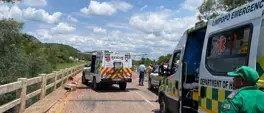VELENKOSINI HLABISA: South Africa’s disaster management system needs urgent modernisation
Velenkosini Hlabisa
20 August 2024 | 8:47Ensuring a new model that works for communities will involve stronger partnerships with the public and private sectors, cutting through bureaucracy to deliver immediate, life-saving aid when disaster strikes, writes Velenkosini Hlabisa.
In a world facing the relentless march of climate change, South Africa, like many nations, finds itself at the mercy of both natural and man-made disasters. Whether it is pandemics, environmental crises or technological catastrophes, the reality is clear: no community is immune.
The United Nations defines a disaster as any event that disrupts the functioning of a community, causing human, economic or ecological harm. These events can strike anywhere, anytime, with devastating impacts, like the recent floods in parts of the Western Cape, and the fierce veldfires that swept through parts of KwaZulu-Natal and Limpopo in July.
Effective disaster management is not just about responding to these crises. Rather, it is about being prepared, ensuring that when a disaster strikes, we can act swiftly, tactically and effectively. This requires the coordination of resources and role players across all sectors - public, private, non-profit and volunteers - to minimise the impact and protect lives.
Our Constitution designates Disaster Management as a shared responsibility between national and provincial spheres of government. While we acknowledge and welcome the fact that South Africa's disaster management framework is well-established, it needs urgent review and modernisation.
For years, the National Disaster Management Centre (NDMC) played a critical coordinating role pre, during and post disasters. Through the NDMC, the aim is to collectively reduce or avoid the potential losses from all types of calamities, ensure prompt and appropriate assistance to victims of disaster, and achieve rapid and effective recovery.
With disasters becoming more frequent and severe, particularly in the context of climate change, we must rethink our approach to disaster management.
Accordingly, the NDMC is undertaking a comprehensive review of the disaster management and fire services system for South Africa, collaborating with stakeholders across the sector. This review aims to close the gaps in our current system which were highlighted through a detailed analysis of literature, reports, benchmarking and international best practices.
The result of this review has been 12 key strategic objectives, seven of which are critical to strengthening our disaster management system:
- Mainstream disaster management in development planning;
- Enhance disaster management capacity;
- Implement an integrated information and communication system;
- Explore innovative funding and risk management solutions;
- Improve coordination and responsibility in disaster management;
- Strengthen institutional arrangements; and
- Enhance disaster resilience through risk assessment, capacity building, and public-private partnerships.
However, weaknesses remain.
The 2015 updates to the Disaster Management Act addressed some emerging issues, but left critical gaps in coordination, mainstreaming and funding unaddressed.
The Constitution’s lack of explicit recognition of disaster management as a local government function complicates legal and financial frameworks. Moreover, the system’s reliance on cooperative governance principles without effective enforcement measures hampers its effectiveness.
The envisioned model for South Africa emphasises risk reduction over mere response and recovery. This model will integrate disaster management into government planning at all levels, ensuring that it is adequately funded and that all government agencies are prepared to protect lives and livelihoods.
This approach, inspired by international examples like Mozambique, California and New Zealand, aims to enhance emergency management and ensure swift, coordinated responses.
In this new model, disaster risk reduction is at the forefront. We will focus on preventing new risks, reducing existing ones, and managing residual risks, all of which are essential to building resilient communities.
To ensure this, we will forge stronger partnerships with both the public and private sectors, cutting through bureaucracy to deliver immediate, life-saving aid when disaster strikes.
At the heart of our work and the new envisioned system is a simple truth: communities must be the priority.
They are the ones who bear the brunt of disasters, and their protection is our ultimate goal. Preparing for disasters saves lives, speeds recovery and reduces costs.
With this new, proactive approach, we are committed to safeguarding our communities and ensuring that no South African is left behind in times of crisis.
Velenkosini Hlabisa is the Minister of Cooperative Governance and Traditional Affairs.
Get the whole picture 💡
Take a look at the topic timeline for all related articles.
















